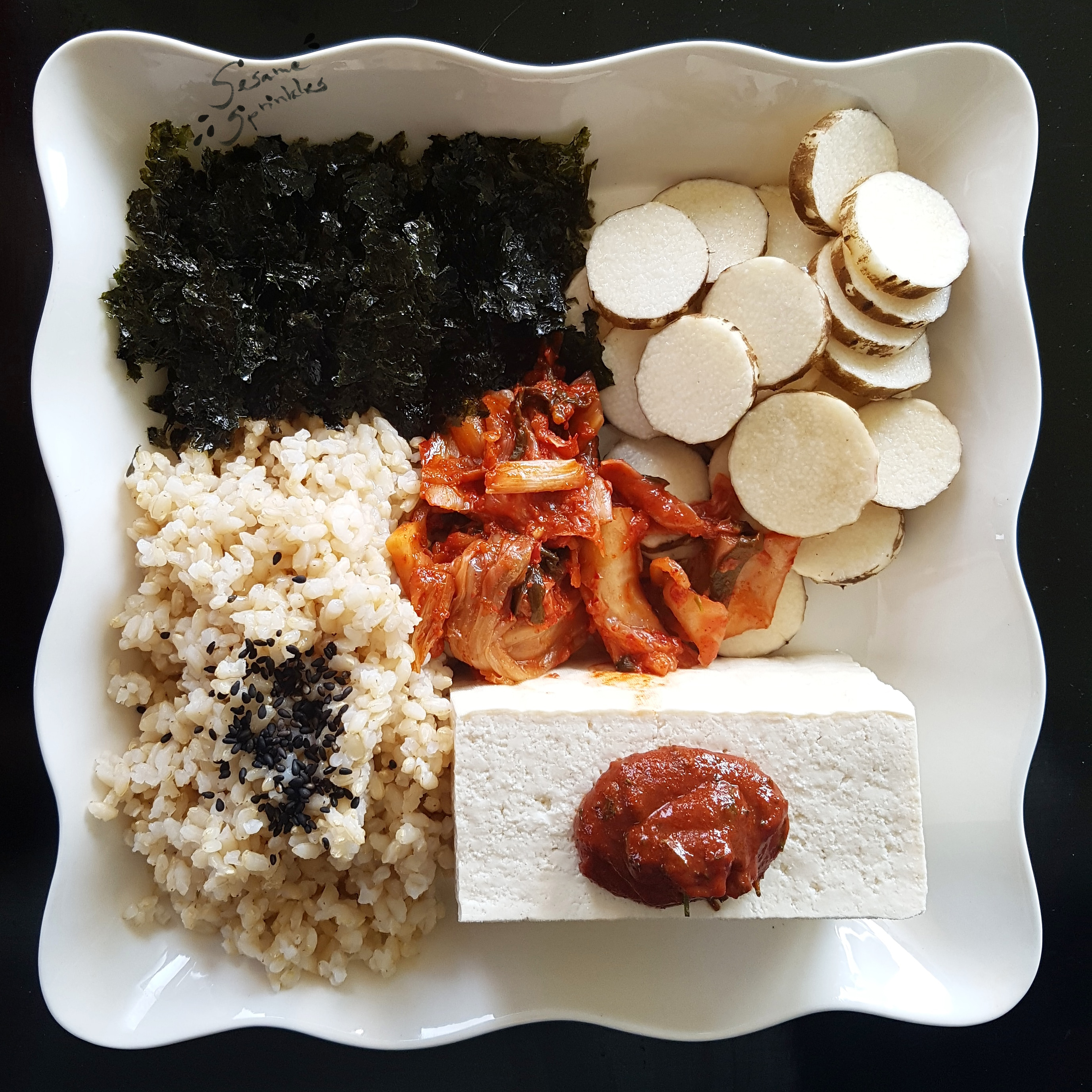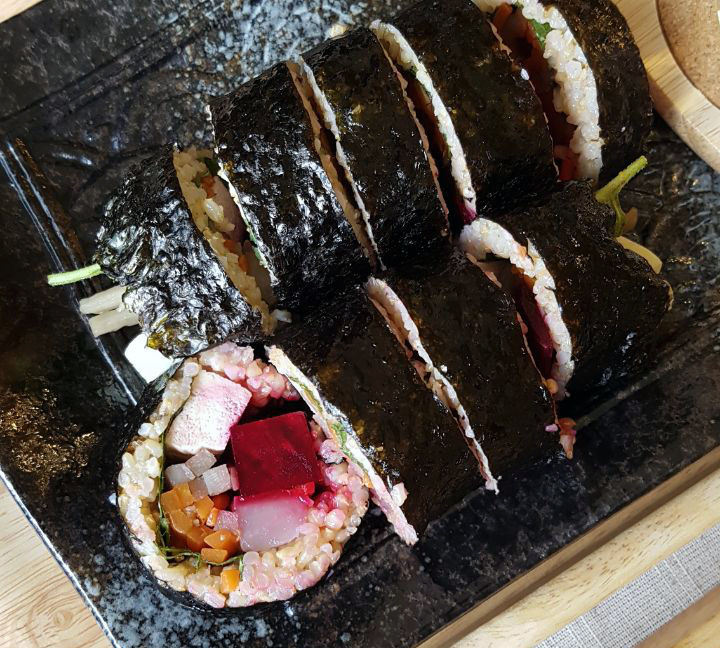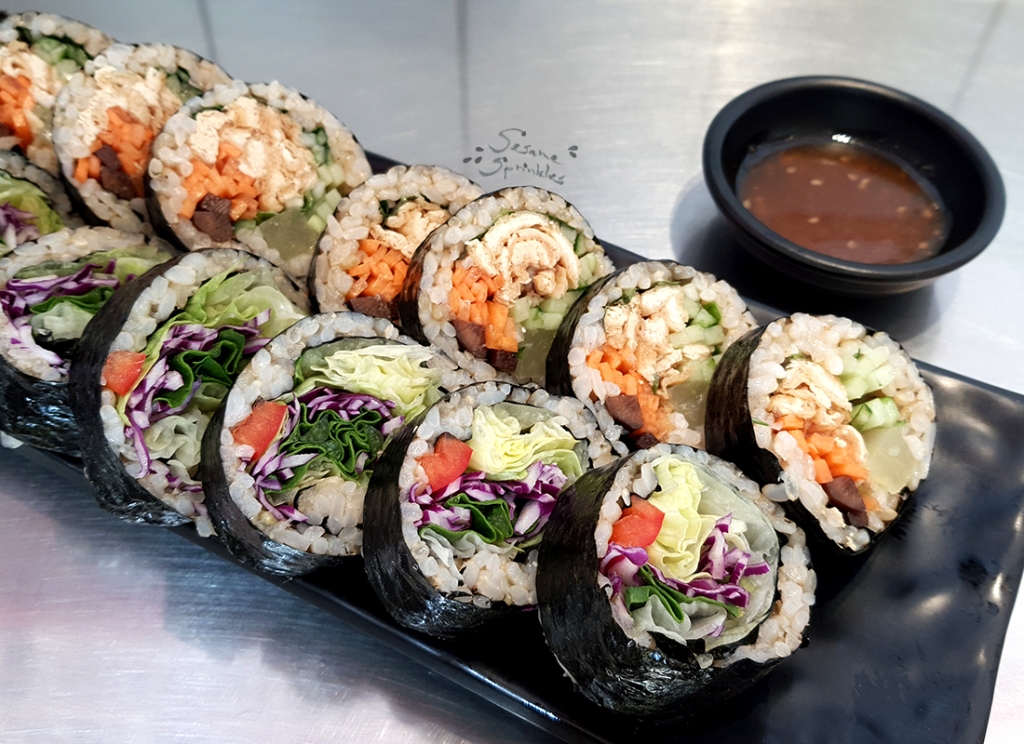
Everyone knows Japanese sushi, right?
🍣🍣🍣🍣🍣🍣🍣🍣🍣🍣🍣🍣🇯🇵 (寿司 / すし)
But did you know about the Korean equivalent Kimbap (김밥, also spelled Gimbap)? 🇰🇷🍣🇰🇵
Basically, it is rice (bap 밥) rolled up in a sheet of seaweed (gim 김), quite similar to the Japanese makizushi (巻き寿司). Only it has WAY MORE fillings!!!🤩💕 A standard Kimbap contains at least five different kinds of fillings at once!
Another difference is that you don’t need to dip the pieces of wrapped rice into any sauce, because everything is already seasoned! And the taste of each roll of Kimbap varies a lot, according to its diverse fillings!
In Korea, there are various types of filling ranging from kimchi to fried pork cutlet 🐖 or beef 🐄 plus the standard vegetables!
The basic filling usually includes carrot 🥕, spinach 🥬, pickled radish, cucumber 🥒, egg 🥚, ham (햄 haem) 🥓, fishcake (오뎅 odeng) 🐟 and crab meat (게맛살 gematsal) 🦀.

When Kimbap is made fresh directly after you place your order, it is specified as jeukseok Kimbap (즉석김밥). Then, it is easy to customize your Kimbap order and request certain ingredients! Therefore, it is a veggie-friendly dish that can be made vegan or vegetarian, if you only know a little bit of Korean! 🌱🍣
According to your preferences, you can order a basic Kimbap and ask for specific ingredients to be put into or omitted from your roll of Kimbap.
Here are some sentences you could use to customize your Kimbap order:
- 🥕 “김밥에 야채만 넣어주세요.” Please put only vegetables into my Kimbap. 🥒
- 🥚 “김밥에 야채하고 계란만 넣어주세요.” Please put only vegetables and egg into my Kimbap.🍳
- 🚫🥓 “햄 빼고 김밥 만들어주세요.” Please make my Kimbap without ham. 🐷
- 🚫🐟 “오뎅이나 게맛살 빼고 김밥 만들어주세요.” Please make my Kimbap without fishcake or crab meat. 🦀
- 🚫🥚 “마요네즈 빼주세요.” Please do not add mayonnaise.

In Seoul, Kimbap is often sold on the street, at subway stations or offered in small restaurants (bunsikjeom 분식점). The price for Kimbap is also relatively low! Some places offer Kimbap for as little as 1500 KRW, although most restaurants begin at 2500 KRW for the most basic roll. Depending on the filling, the price may get higher, but Kimbap is normally no more expensive than 4000 KRW in contemporary South Korea. 💲
Kimbap is generally consumed as a snack, small meal, a kind of appetizer or served even as finger food at parties.
If you get it on the street or in a restaurant, Kimbap is always available for to-go (wrapped into aluminum foil or packed into boxes). Kimbap is an abundant, nutritious, basic food – just like the sandwich in the Western world. An easy meal when in a rush 🚴♂, outdoors 🧗♂ or on a picnic ⛱! You can eat it even with your fingers 👌 when chopsticks 🥢 are not available. There’s also no need to carry sauce in an extra container. In other words, Kimbap is an ideal take-away meal! 🥡
[In this regard, it has a completely different standing if you think about the fancy way in which Japanese sushi is served in the Western world!]
After all, there are endlessly many variations of Kimbap. If you make it yourself, you can fill it whatever you want to eat! 👨🍳🧑🍳👩🍳 You can even replace the regular white rice with brown rice or quinoa to add more nutrients and texture!

In contemporary South Korea, there are a couple of classic combinations, not all of them are vegan or vegetarian but most of them can be modified. Here are a couple of veggie-friendly ones which are normally easily customized:
- Vegetable Kimbap (yachae kimbap 야채김밥) – filled with various vegetables and mayonnaise (plus egg and ham)
- Kimchi Kimbap 김치김밥 – filled with Kimchi and egg
- Mini Kimbap (미니감밥 / 꼬마김밥) – small rolls of Kimbap, either with no filling or with vegetable filling
- Mayak Kimbap 마약김밥 (literally “Drug Kimbap”) – small rolls of Kimbap, served with a special dipping sauce












When I first came to Korea, 20+ years ago, this was my go-to. I couldn’t speak the language, but I could point to what I wanted! It’s also one of the most fun Korean foods to make, and you can experiment with anything you like!
LikeLiked by 1 person
Wow, I imagine, it really must have been hard to find food in Korea at the time! 0_0 I used to eat Bibimbab 비빔밥 everyday at the beginning and was so happy whenever I discovered a new veggie-friendly dish…
LikeLike
I ate it at least once a day– but only at a few restaurants near my job (Sejong University, at the time) where I had Korean friends explain my diet and I knew it was “safe”! I like the honesty and caveats in your blog! Great work!
LikeLiked by 1 person
Thank you so much for the feedback! 🙂 I learn every day and the challenge continues..
LikeLike